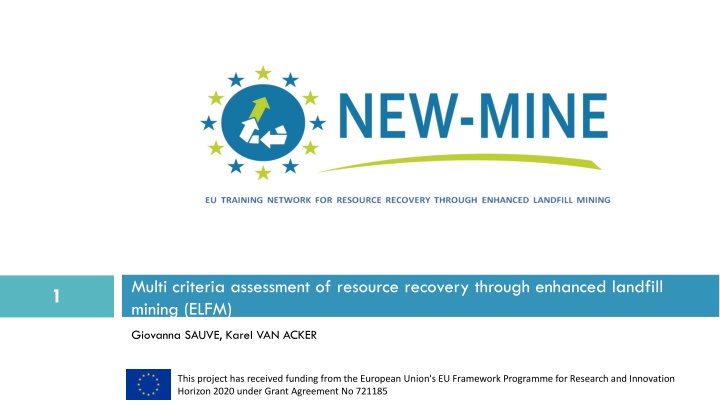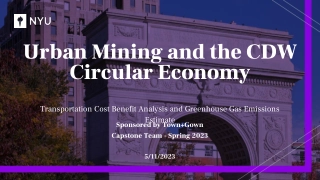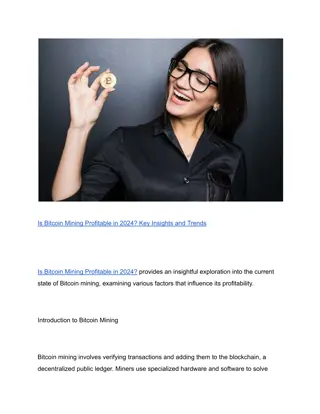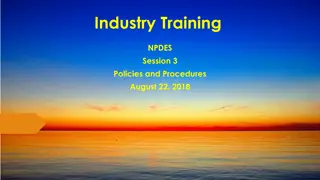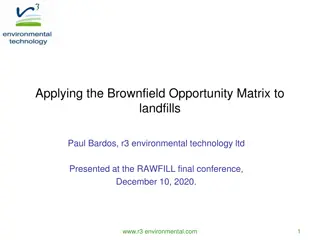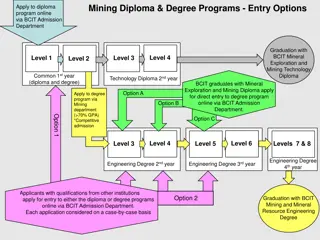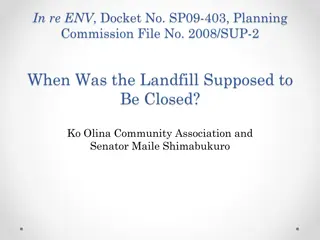Enhanced Landfill Mining: Multi-Criteria Assessment for Resource Recovery
This project delves into the assessment of resource recovery through Enhanced Landfill Mining (ELFM) using a multi-criteria approach. It explores the goals, drivers, and objectives of ELFM, emphasizing environmental protection, societal benefits, and economic considerations. The study highlights the importance of techniques like Life Cycle Assessment (LCA) and Risk Assessment (RA) in decision-making and the valorization of landfilled waste streams for both material and energy recovery.
Download Presentation

Please find below an Image/Link to download the presentation.
The content on the website is provided AS IS for your information and personal use only. It may not be sold, licensed, or shared on other websites without obtaining consent from the author.If you encounter any issues during the download, it is possible that the publisher has removed the file from their server.
You are allowed to download the files provided on this website for personal or commercial use, subject to the condition that they are used lawfully. All files are the property of their respective owners.
The content on the website is provided AS IS for your information and personal use only. It may not be sold, licensed, or shared on other websites without obtaining consent from the author.
E N D
Presentation Transcript
Multi criteria assessment of resource recovery through enhanced landfill mining (ELFM) 1 Giovanna SAUVE, Karel VAN ACKER http://new-mine.eu/wp-content/uploads/2016/10/flag_yellow_low.jpg This project has received funding from the European Union's EU Framework Programme for Research and Innovation Horizon 2020 under Grant Agreement No 721185
Goal of the presentation 3 Enhanced landfill mining (ELFM) The role of Multi Criteria Assessment (MCA) in decision making Multi-criteria assessment approach in the NEW MINE project Conclusions
Enhanced Landfill Mining 4 Excavation Landfill Landfill (Transport) (Transport) Reference case Sorting Disposal: Re-landfilll (Transport) (Transport) Thermal Treatment Material recycling Laner et al., 2016 the safe conditioning, excavation and integrated valorisation of landfilled waste streams as both materials (Waste-to-Material, WtM) and energy (Waste-to-Energy, WtE), using innovative transformation technologies and respecting the most stringent social and ecological criteria (Jones et al., 2013)
Drivers for ELFM 5 Recovery of resources, land, landfill space Environmental protection Societal benefits Mont Saint Guibert landfill (2017)
The Multi Criteria Assessment 6 ENVIRONMENT Life cycle assessment (LCA) Risk assessment (RA) SOCIETY Social life cycle assessment (S- LCA) ECONOMY Techno-economic assessment (TEA) Life cycle costing (LCC)
Overview of an ELFM project 8 Environmental protection + Avoided aftercare/remediation Recovered land Excavation Recovered landfill voidspace Landfill ELFM support Landfill (Transport) (Transport) Reference case Separation Mitigation of risks to HHE Disposal: Re-landfill Minimization of waste re-landfilling (Transport) (Transport) COSTS and Thermal treatment Material recycling (Transport) IMPACTS BENEFITS and REVENUES Energy Recovery and Material recovery and sales NWE6 EU MSCA-ETN NEW-MINE, September 2019, Bergamo - Italy sales
Critical factors 9 Waste composition Landfill location Landfill reference case Safety regulations Technology choice and efficiency Quality Logistics Costs: energy, processing, investment, O&M, etc., Land recovery Avoided impacts Stakeholder involvement Investment incentives Background systems Transportation Financial effects Materials and energy prices Market acceptance Legal, institutional, organizational, and societal structures Public acceptance SITE-LEVEL PROJECT- LEVEL SYSTEM- LEVEL
Summary of the critical factors 10 Technology availability and choice Waste and landfill types Project acceptance Landfill aftercare and remediation Markets Regulations
11 How to account for factor variability the feasibility assessment feasibility assessment of ELFM projects? settings, technology choices, market and policy settings, technology choices, market and policy conditions conditions To address uncertainties uncertainties To understand what factors build the environmental factors build the environmental and economic performance and economic performance of ELFM scenarios factor variability in Multiple scenarios: Multiple scenarios: To assess the implications of different site different site- -specific specific
Multi-criteria assessment of plasma gasification in ELFM 12 - 2187 scenario - Understand under what conditions plasma gasification could be feasible in the ELFM context - Understand what main factors influence the environmental and economic performance? [Sauve G., Esguerra J.L., Laner D., Krook J., Svensson N., Van Passel, S., Van Acker K., Integrated early-stage environmental and economic assessment of emerging technologies: A case study of plasma gasification, (To be submitted)]
Critical performance factors 14 Economic results Environmental results o Gasifying agent (project-level) o Gasifying agent (project-level) o Market prices (system-level) o Background energy system (system- level) o Financial accounting (system-level) o Slag management (project-level) o Quality of the feedstock (site-level) o Quality of the feedstock (site-level)
Critical performance factors 15 Integrated environmental and economic results o Gasifying agent (project-level) o Market prices (system-level) o Slag management (project-level) o Substitution rates (system-level)
The role of policy and market interventions 16 Marketability of recovered resources Local/regional market quality standards and acceptance of secondary raw materials Competition with primary raw materials Lack of clear and specific regulations for ELFM Societal and regulatory uncertainties that hinder the public acceptance and investments in ELFM Current market structure hinders resource recovery from landfills
Conclusions 17 Aim of the multi-criteria assessment: o Understand under what conditions ELFM could be feasible Where and how to implement ELFM: o Local conditions and project settings o Technology choices and efficiencies for excavated waste o Technology readiness level (TRL) Role of market and policy interventions: o Market structure, quality standards and prices o Recognition and institutionalization of ELFM
The NEW-MINE project has received funding from the European Union's EU Framework Programme for Research and Innovation Horizon 2020 under Grant Agreement No 721185. 18 Thank you very much for your attention!
